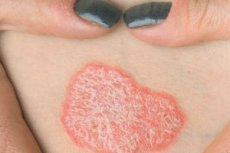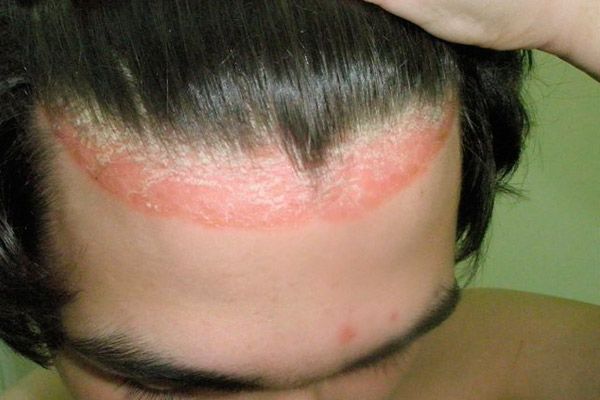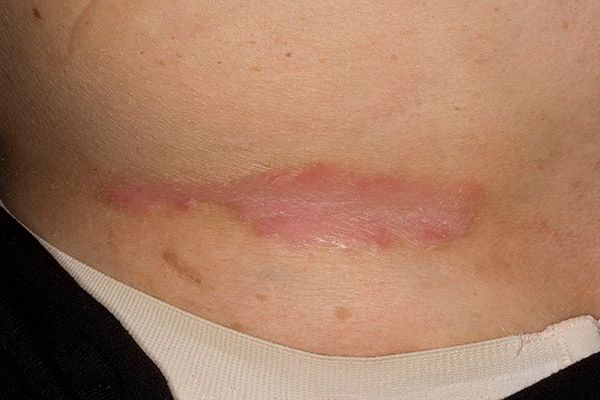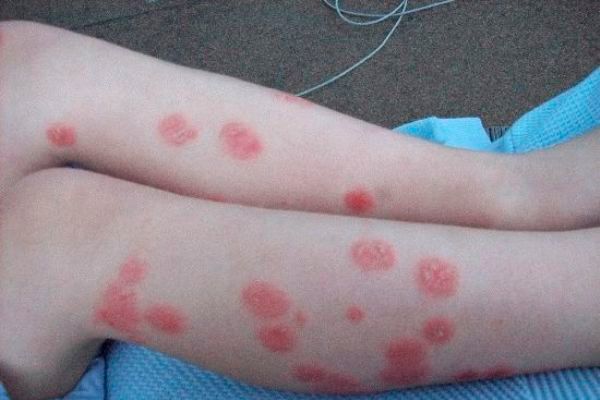Medical expert of the article
New publications
First symptoms of psoriasis: in women, men and children
Last reviewed: 04.07.2025

All iLive content is medically reviewed or fact checked to ensure as much factual accuracy as possible.
We have strict sourcing guidelines and only link to reputable media sites, academic research institutions and, whenever possible, medically peer reviewed studies. Note that the numbers in parentheses ([1], [2], etc.) are clickable links to these studies.
If you feel that any of our content is inaccurate, out-of-date, or otherwise questionable, please select it and press Ctrl + Enter.

Although psoriasis is a group of infectious diseases that do not pose a danger to others, for a person who has discovered some manifestations of this disease, this is already a reason to sound the alarm. Once it appears, in its development the disease begins to cover ever larger areas of the skin and affect the functioning of some body systems, so it is so important to pay attention to the first signs of psoriasis and start treatment in time, not allowing the pathology to take power into its own hands.
Considering that psoriasis has several types, as well as gender and age characteristics of patients, it is necessary to understand that the manifestations of psoriasis in each specific case can differ significantly. What should you pay attention to in order not to miss the development of the disease and take all necessary measures to prevent its spread in a timely manner?
Psoriasis in women, men and children
Psoriasis is a disease for which age and gender do not matter much. It can occur even in childhood, changing the child's life for many years. It can be said that no one is immune from psoriasis. The mechanism of the disease itself has not yet been thoroughly studied, and the reasons for its development are so diverse that it is very difficult to prevent the onset of the event. However, in order to catch the onset of the disease, it is very important to familiarize yourself with some patterns and features of its occurrence in various groups of patients.
Although the first signs and later manifestations of psoriasis in patients of both sexes are generally similar, there are some differences in the causes and time of development of the pathology. For example, in females, the early development of psoriasis is associated with the first period of significant hormonal changes, covering the age of approximately 15 to 20 years. At this time, the risk of developing the disease is especially high.
The second peak of hormonal changes in the female body can be considered the onset of menopause. This occurs at the age of about 40-50 years, because the timing of the onset of the climacteric period is strictly individual. During this period, both the development and exacerbation of an existing pathological process can be observed.
The period before menstruation, characterized by a certain hormonal surge, can also serve as a signal for the onset or exacerbation of the disease. For the same reason, psoriasis is often diagnosed in pregnant women.
As for the varieties of the disease, women more often than men develop psoriasis of the folds localized in the chest area. This is due to the physiological features of the structure of this part of the female body, where the moments of sweating and friction of skin areas against each other and against clothing are especially important.
The most dangerous period for men, when the development of psoriasis is again associated with hormonal changes, is considered to be the age of 20-23 years. It is at this age that the probability of developing pathology is especially high, which is confirmed by a large number of cases of diagnosing the first signs of psoriasis in young people.
Childhood psoriasis is somewhat different from adult psoriasis. Infants, like women, have a special predisposition to developing psoriasis in these areas due to the large number of skin folds. In appearance, it resembles diaper rash with redness and moisture on the surface of the affected area, sharply demarcated from healthy skin.
In older children, psoriasis also has its own characteristics. This mostly concerns the localization of psoriatic spots, which is not typical for the disease. The affected areas in children over one year old can be observed on the face or genitals.
There is a type of psoriasis (guttate), which is diagnosed mainly in childhood and adolescence. In this case, small rashes resembling drops are observed. Such areas are located symmetrically, the rash on them usually has a rich red or slightly purple hue, tends to grow quickly and peel.
How does common psoriasis begin?
With common, or vulgar, psoriasis, the situation is more or less clear. It has its own special manifestations, not typical of other skin diseases, which makes diagnosis easier.
The main symptom of vulgar psoriasis is the appearance of specific rashes - psoriatic plaques, which are convex bright pink or reddish areas of skin with silvery scales. But at the very beginning of the disease, plaques are most often not observed, at the site of their future development, you can see several pink seals (papules), located, as a rule, in the area of the scalp or joints (elbow - on the hands or knee and ankle in the case of psoriasis on the legs). The appearance of papules is the first sign of the development of vulgar psoriasis.
The danger of such manifestations is that they can simply be ignored. They do not bother the patient much, since they are almost indistinguishable from acne or allergic rashes, almost do not itch and do not cause pain. Peeling on the surface of the papules does not occur in all cases, it is usually noticeable when the seal is carefully scraped off.
There is another important point. Papules, which are the initial symptoms of psoriasis, tend to decrease and even disappear completely under the influence of sunlight, which happens in the summer.
The acute form of simple psoriasis begins immediately with a profuse, noticeable rash, which also itches a lot, resembling an allergic rash. And only scraping the surface of the papules allows diagnosing psoriasis by its characteristic peeling, terminal shiny film and bloody dew (microscopic bleeding on the surface of the papule when scraped).
How not to miss the onset of seborrheic psoriasis?
Seborrheic psoriasis is so called because the disease begins on the scalp, gradually spreading to the face, neck, shoulders. The first signs of this type of psoriasis may not attract the patient's attention for a long time. After all, normal peeling without the formation of papules and plaques with slight redness can simply be mistaken for banal dandruff. Such a process can continue for a long time, confusing both patients and doctors.
Only when treatment with special shampoos, creams and emulsions against dandruff does not help, a person seeks help from a dermatologist, whose task is to determine what he is dealing with: “inveterate” seborrhea or seborrheic psoriasis.

If the process is started and effective treatment is not started in time, the symptoms of psoriasis will gradually cover larger surfaces, moving to the forehead and areas behind the ears along the hairline. Over time, psoriatic plaques begin to appear at the site of peeling, which cannot be hidden with hair so easily.
Attention: insidious psoriasis of folds!
Psoriasis can appear not only on the head or limbs, but also in places with high humidity, on the folds of the skin. Such areas include the skin in the armpits, under the breasts (especially in women), in the groin and on the genitals.
The first signs of psoriasis of the folds are the appearance of bright red spots, almost not raised above the surface of the skin, with a shiny, smooth surface, slightly damp to the touch. Rarely, cracks are noted on the affected surface.

The insidiousness of this type of psoriasis is that due to the lack of noticeable peeling and itching, it is mistaken for ordinary irritation due to constant moisture and possible friction. This applies to the armpits and areas of the body under the mammary glands. Difficulties with diagnosis are also caused by the localization of the disease on the genitals. Psoriasis of the folds is very easily mistaken for balanoposthitis in men and vulvitis in women. These diseases are characterized by similar symptoms - rashes on the external genitals.
 [ 1 ], [ 2 ], [ 3 ], [ 4 ], [ 5 ], [ 6 ], [ 7 ], [ 8 ]
[ 1 ], [ 2 ], [ 3 ], [ 4 ], [ 5 ], [ 6 ], [ 7 ], [ 8 ]
The first signs of psoriasis on the limbs
The palms and soles are also favorite places for psoriasis to develop. This type of pathology is sometimes called palmoplantar psoriasis, which most often occurs when the disease has already developed in other areas of the body.
On the hand, psoriasis can be located not only on the palms, but also on the back of the hand, on the fingers and the skin between them. The first signs of psoriasis of the palms are the formation of red inflammatory lesions covered with flaky skin, on which cracks periodically appear. Very quickly, the skin in the affected areas becomes rougher, and scaly plaques of a rounded shape appear on it, which can be scattered or merge together. Severe itching begins.
Next, complaints appear about dry palms and painful sensations when moving the hand and fingers, while the sensitivity of the fingers themselves noticeably deteriorates.
Psoriasis of the feet, which is most often diagnosed in women after menopause and in people whose activities are associated with the risk of foot injury, usually affects the skin on the soles and between the toes. It is characterized by dense papular rashes with a clear border.

Sometimes the papules look like moist, whitish, clearly defined seals. This pathology is called whitish psoriasis.
In some cases, papules can merge and form lesions resembling a callus with yellowish scales. The surface of such a formation is quite dense and difficult to scrape off, which significantly interferes with the diagnosis of the disease. Such "calluses" are prone to cracking, which results in painful sensations, difficulty in walking and performing professional duties.
Palmoplantar psoriasis may look different. Blisters with transparent yellowish contents form on the skin, located deep in the skin (pustules), which subsequently burst. The skin in their place dries out, and bleeding cracks form on it. This type of psoriasis of the extremities is called palmoplantar pustulosis.
The first signs of psoriasis of the extremities are very often various changes in the appearance and structure of the nail plate (psoriatic onychodystrophy), which manifest themselves in a change in the color of the nail, the appearance of white dots, spots and stripes on its surface, as well as focal hemorrhages under the nail plate. The nail becomes brittle and exfoliates, sometimes noticeable thickenings appear on the nail.
Later, inflammatory lesions may appear on the skin around the nail and spread to the interdigital space. Until then, all symptoms may indicate both the development of a fungal infection and the onset of nail psoriasis. Only a specialist can make a correct diagnosis in this case based on certain studies. But the very fact of changes in the nail plate should alert those who have had cases of psoriasis in their family.
What to do if you suspect psoriasis?
Above, only skin manifestations of psoriasis, characteristic of the initial stage of the disease, were described. They may be accompanied by other symptoms of psoriatic disease, such as rapid fatigue, general weakness, depression. These manifestations in themselves do not indicate psoriasis. Such symptoms are characteristic of most more or less serious pathologies. But against the background of skin rash and the formation of specific plaques, they most likely indicate the development of psoriatic disease, which should be a signal for immediate action.
Despite the fact that the disease is still considered incurable, it should not be treated as inevitable. There are many effective methods and means that can slow down the development and spread of the disease to other parts of the body, reduce the manifestations of the disease for a more or less long time or remove the symptoms altogether, allowing a person to live a full life. The main thing is to notice the first symptoms of psoriasis in time and seek help from a medical institution, where a specialist doctor, after conducting diagnostics and clarifying the diagnosis, will prescribe effective treatment.
When you detect the initial symptoms of the disease, you should not go to extremes: give up, plunging headlong into your experiences, or, on the contrary, rush into all seriousness, trying on yourself various methods and means, the advertisements of which are strewn across the Internet. Such self-medication is fraught with the fact that precious time will be spent on effective procedures, and the disease will gradually move to the next stage of development, when its treatment will already be difficult.
If an incomprehensible rash appears on the skin, do not wait until it spreads to large areas of the body or manifests itself with other symptoms. A visit to a dermatologist in this case is the only correct decision. Only a specialist doctor can diagnose psoriasis in the early stages, when its manifestations are similar to the symptoms of other diseases. And then additional studies precede the diagnosis.
In addition, psoriasis is a rather peculiar disease, characterized by seasonal manifestations. In summer, psoriasis symptoms may disappear, which sometimes only delays the process of diagnosis and treatment of the pathology.
Psoriasis can manifest itself in different ways and in relation to different medications. By prescribing medications to yourself, you can not only delay the improvement of the condition, but also cause an exacerbation of the disease. The same applies to medical procedures prescribed by doctors as part of the treatment of other diseases. This applies not only to medications, but also to dietary supplements, vitamin complexes, and various procedures.
All such prescriptions must be reported to the dermatologist, and when the diagnosis of psoriasis is confirmed, it must be mentioned when you are prescribed medications for the treatment of pathologies not associated with psoriatic disease.
Summer sun, fresh air, sea treatments and hygiene procedures have a positive effect on both the condition of the skin affected by psoriasis and the general well-being of the patient. This should not be neglected!
Improper nutrition and a disturbed mental state can negatively affect the development of the disease. Therefore, when the first signs of psoriasis appear, you need to ensure that stress and bad mood do not cause an exacerbation of the disease. To this end, it is worth learning the basics of self-regulation of the neuropsychiatric state or seek help from a psychologist. At the same time, it is advisable to start following a special diet that excludes alcohol and reduces the consumption of unhealthy foods, such as sweets, smoked foods, canned goods, spicy, fatty dishes and products containing preservatives. And believe me, if you want to do this, it is not as difficult as it seems.

